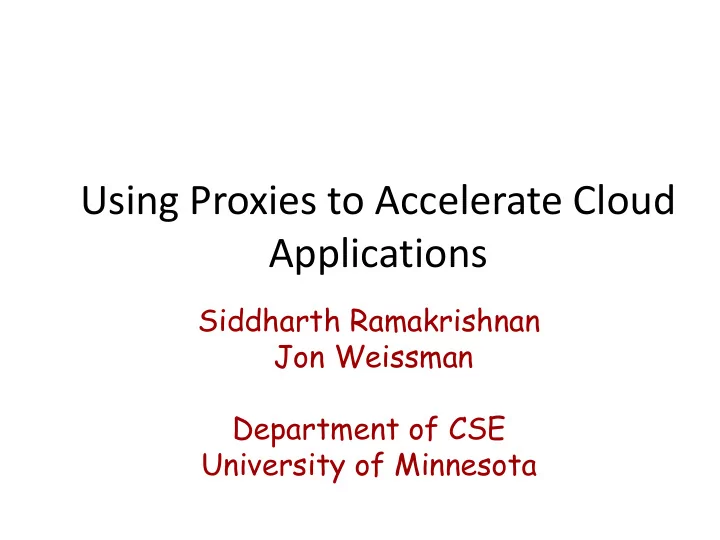

Using Proxies to Accelerate Cloud Applications Siddharth Ramakrishnan Jon Weissman Department of CSE University of Minnesota
Introduction • Cloud ecosystem (Gannon 2009) – SAAS: (Google Spreadsheet, Gmail) – I/P-AAS: (Virt: EC2/S3, Azure), Google AppEngine – Parallel frameworks: (MapReduce cloud) • Scale-up/Scale-down • Remote execution/hosting • Performance • Transparency
Application View: Cloud Diversity • Data clouds – S3, SkySurvey, GoogleHealth, … • Compute clouds – EC2, IronScale, … • Service clouds – Gmail, Gmaps, Google-earth
Trends • Specialization and diversity – Functional and non-functional – Non-functional: security, reliability, SLAs, cost – Functional: type of data, type of services, … • Distributed clouds – Smaller footprint data center containers geographically dispersed – Logical cloud federation: OpenCirrus
Confluence • Diversity of clouds + push for distribution • (1) No single cloud model will rule • (2) New distributed models are attractive • (3) Emerging applications will utilize multiple clouds “multi-cloud” applications
An Aside: Edge Systems • Edge systems – Compute-oriented: BOINC, @home, … – Data-oriented: P2P, Bittorent, openDHT, … Appeal: scale, cost, *diversity* => Edge computers can play an important role in multi-cloud applications
Multi-Cloud Applications • Specialization => data-intensive applications will increasingly span multiple clouds – data is dispersed across multiple clouds • Distributed data mining – Ex: weather data + commodity prices • Scientific workflows – Ex: life science: GenBank<->BLAST<->PubMed, … • Mashups – Ex: GoogleEarth + CDC pandemic data • Multi-cloud parallel frameworks – Ex: MapReduce, AllPairs, …
The Problem • Current cloud interaction paradigm is client-server – Web Services or http • Data flows back and forth to end-client application S 2 S 1 Better available nodes E compute on S 1 output
Solution: Proxy Architecture: 50K ft Resource constrained Exploit diversity of proxy nodes
S 2 S 1 P E Proxy Network
Data-oriented Proxy Roles • Cloud service interaction – Proxy as a client • Routing – Proxy routes data to other proxies • Computing => Grids – Proxy computes data operators: compress, filter, merge, mine, … • Caching => P2P – Proxy caches data (from cloud, computations, …)
Proxy Network • Where do proxies come from? – volunteers, deployed CDNs, … • How do proxies form overlays? – is there a system-wide overlay and/or application- specific overlays? – need more experience with multi-cloud applications
How Much Network Diversity? • Extensive evaluation of PlanetLab and Internet services Need download 1. Cluster of good proxies 2. Best proxy depends on cloud service
Proxy Hop Penalty? • Despite network proximity and data reduction, proxies may add a network hop – 1600 paths – Over 70% benefited by intermediary S 1 – Over 20% performance improvement P E
Example: Montage
Montage Speedup Initiator is the workflow engine, remote from Montage services One proxy per Montage service, co-located
Example: Image Processing Basic workflow Enhanced proxy workflow
Results end-user image server location fixed There exist many proxies that can accelerate this application Image processing cloud location
Summary • Cloud specialization will trigger a new wave of multi-cloud applications • Proposed a proxy network to “accelerate” these applications => bottleneck awareness • Many research challenges – Proxy node selection – Proxy network configuration
Recommend
More recommend